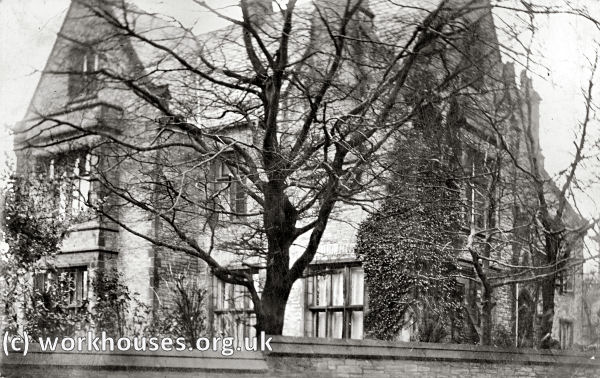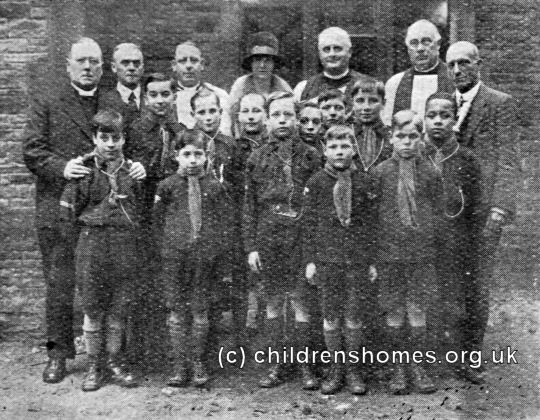St George's Home for Boys, Salford, Lancashire
The St George's Receiving Home was opened by the Waifs and Strays Society in 1917 at 224 Great Clowes Street, Higher Broughton, Salford. It housed 20 children under the age of 12 coming in to the Society's care, before they were despatched to one of the branch homes.
In 1928, the existing premises were closed and a new St George's Home, a branch home for boys, opened on Vine Street, in the Kersal area of Salford.

Kersal Rectory, Salford, c.1911. © Peter Higginbotham
The home was established in the former Kersal Rectory which was purchased for the sum of £1,500. The formal opening, by Lady Aubrey-Fletcher, took place on October 10th, 1928, with the Bishop of Middleton (substituting for the Bishop of Manchester) conducting a service of dedication. The architect for the building's conversion was Mr Isaac Taylor. The home could accommodate 45 boys aged from 7 to 15, some of whom — dressed in their Boys Scout uniforms — formed a guard of honour.

Opening of St George's Home for Boys, Salford, 1928. © Peter Higginbotham
At the outbreak of the Second World War in 1939, the boys were initially evacuated to the Fleetwood home. In 1943, they moved to Pont-y-Pant in North Wales.
In 1949, the Kersal home re-opened as the St George's Home for Diabetic Boys. It was the Society's second home (or 'hostel') for diabetic children, being established shortly after the St Monica's Home at Kingsdown, near Deal in Kent. Emphasis was placed on the boys taking responsibility their own care, whether through monitoring their diet or in administering their own insulin injections. In other respects, the hostel was much like any other children's home of the time. The boys attended local schools, joined local Boys Scouts and Wolf Cub groups, and took part in sporting activities.
The home closed for urgent repairs in 1966, but it did not re-open until 1969, with the property having being entirely rebuilt. From 1975 until its final closure in around 1980, the home served as a general branch home.
None of the various St George's Home premises survives.
Records
Note: many repositories impose a closure period of up to 100 years for records identifying individuals. Before travelling a long distance, always check that the records you want to consult will be available.
- Index of the Society's first 30,000 children's case files ordered by surname.
- Index of the Society's first 30,000 children's case files ordered by date of birth.
- The Children's Society Records and Archive Centre is at Unit 25, Springfield House, 5 Tyssen Street, London E8 2LZ (email: archives@childrenssociety.org.uk). Files for children admitted to its homes after September 1926 were microfilmed in the 1980s and the originals destroyed. Some post-1926 files had already been damaged or destroyed during a flood. The Society's Post-Adoption and Care Service provides access to records, information, advice, birth record counselling, tracing and intermediary service for people who were in care or adopted through the Society.
- The Society has produced detailed catalogues of its records relating to disabled children, and of records relating to the Children's Union (a fundraising body mostly supported from the contributions of children).
Bibliography
- Bowder, Bill Children First: a photo-history of England's children in need (1980, Mowbray)
- Church of England Waifs and Strays' Society [Rudolfe, Edward de Montjoie] The First Forty Years: a chronicle of the Church of England Waifs and Strays' Society 1881-1920 (1922, Church of England Waifs and Strays' Society / S.P.C.K.)
- Higginbotham, Peter Children's Homes: A History of Institutional Care for Britain's Young (2017, Pen & Sword)
- Morris, Lester The Violets Are Mine: Tales of an Unwanted Orphan (2011, Xlibris Corporation) — memoir of a boy growing up in several of the Society's homes (Princes Risborough, Ashdon, Hunstanton, Leicester) in the 1940s and 50s.
- Rudolf, Mildred de Montjoie Everybody's Children: the story of the Church of England Children's Society 1921-1948 (1950, OUP)
- Stroud, John Thirteen Penny Stamps: the story of the Church of England Children's Society (Waifs and Strays) from 1881 to the 1970s (1971, Hodder and Stoughton)
Links
- Hidden Lives Revealed — the story of the children who were in the care of The Children's Society in late Victorian and early 20th Century Britain.
- The Children's Society
Except where indicated, this page () © Peter Higginbotham. Contents may not be reproduced without permission.


